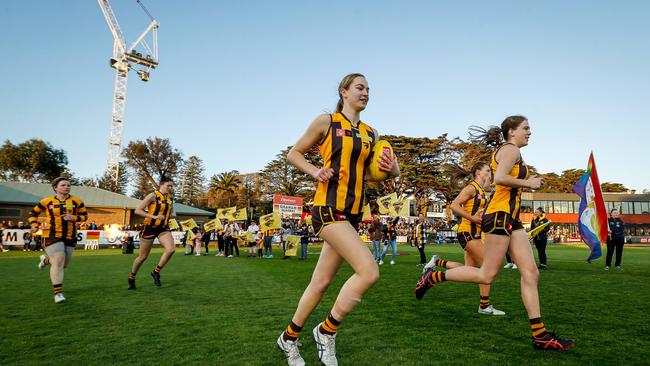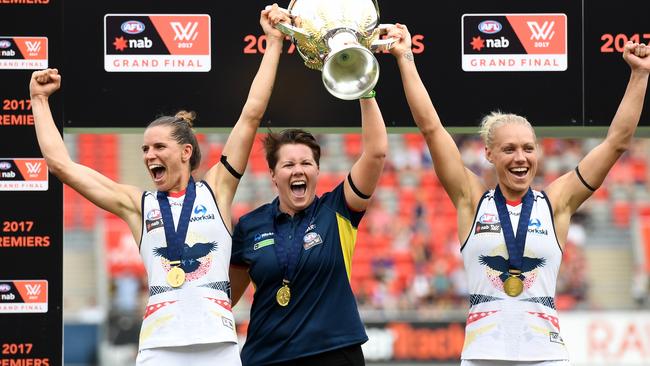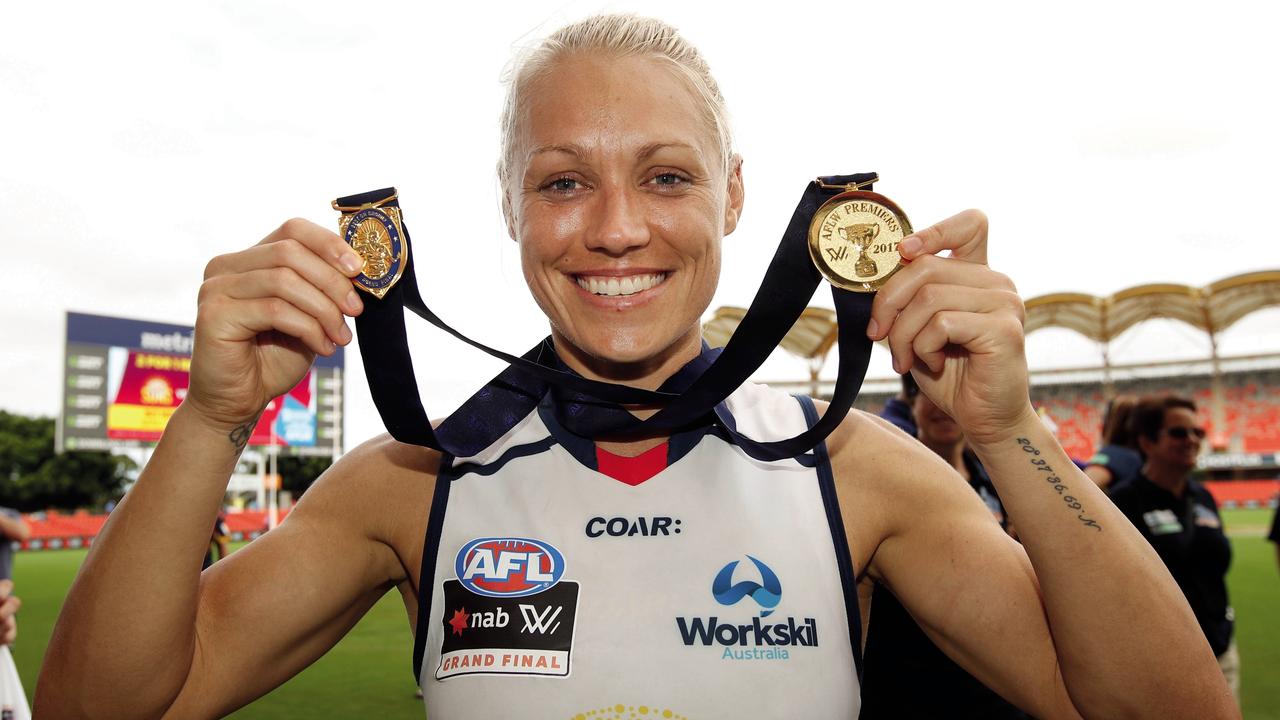No fixture, no deal: Just 51 days out from Season 8, where are things at with AFL Women’s?
The eighth season of AFL Women’s kicks off in 51 days and there’s no public fixture, no pay deal and, some say, ‘no vision’. Where exactly are things at?
AFLW
Don't miss out on the headlines from AFLW. Followed categories will be added to My News.
How has it come to this? Again?
The AFL Women’s season is set to start in 51 days.
There’s been no public release of the fixture. No confirmed season length, even.
With the season slated to begin on September 1, this is the equivalent of being January 24 – week two of the Australian Open and teams slogging it out in a hot pre-season session – and having no men’s fixture.
Clubs and broadcasters have details of the proposed fixture that the AFL wants to announce, but needs a deal with players.
Questionable fixturing – both in locations and timeslots – has plagued the competition and, as one senior industry figure said, “it’s as if they’re wanting it to fail”.
The new fixture distributed to clubs has Hawthorn’s clash against Essendon – a match-up that was moved to Marvel Stadium last season and drew more than 12,000 people – slated for Frankston’s SkyBus Stadium, 41km from Melbourne’s CBD with a capacity of 5000.
In the provisional fixture, last year’s premiers Melbourne has also been scheduled to play at that ground. In the traditional southeast corridor that houses thousands of Hawks and Demons supporters. At 5.05pm on a Friday.

Head-scratching.
Daily collective bargaining agreement talks – for both the women’s and the men’s competitions – remain ongoing.
And it is this new deal that will be more critical than any before it in determining the future of AFLW and its ultimate direction.
The feeling among some players is that of disrespect, lack of faith and lack of investment. All the while, Australia’s pre-eminent female sporting outfit, the Matildas, prepare to host a Women’s World Cup. A game against Ireland housing more than 80,000 fans sold out last week.
There’s murals and merchandise and television advertising.
On AFLW, there’s radio silence.
In year one – which the AFL is using as its reference point when illustrating waning numbers – wall-to-wall TV and billboard advertising drenched the landscape, which we haven’t seen since.
There’s been issues with the game’s growth since day dot and now they’re trying to use what was seemingly an inevitable decline as a bargaining chip, only just seeing the competition and its complexities clearly for the first time.
Come on.
This is a not-for-profit organisation whose remit is growing the game. The same organisation that earlier this year reported a year-on-year operating profit increase of almost $70 million.
The league released a “vision” for the game’s development by 2030, but those at clubs lament years of a lack of direction and clarity.
As one AFLW player put it, the league “wants to have its cake and eat it too”.
“The AFL is happy to shout its participation numbers from the rooftop every year when women’s and girl’s football is growing exponentially,” they said.
“That’s registration fees, part of which go to AFL Victoria, apparel money for clubs … the flow-in of money and feet to community clubs from having women and girls play is huge.
“A large part of that is a result of AFLW. But imagine how those young girls feel seeing that the AFL doesn’t believe in its own product.”

The AFL has been citing “key metrics” – namely attendances and broadcast viewership numbers, as revealed by this masthead more than a fortnight ago – as its reasoning behind putting the brakes on the number of games for a couple of years at least.
One “key metric” not being mentioned is facility redevelopment as a result of the women’s game, with the Victorian government alone contributing more than $125 million to upgrade or redevelop facilities for AFLW at clubs and grounds since 2020.
That “product” has been touted as one of the competition’s most “proud” flagships. In announcing the last CBA – which significantly boosted player salaries – league boss Gillon McLachlan said certainty was paramount with a league that “truly values the contribution of our players”.
“In order to sustain the continued growth of the NAB AFLW competition, we will need to keep investing in the next generation of players, coaches, umpires, administrators, and the next generation of people who will watch, attend, and financially support the growth of football into the future,” McLachlan said in announcing the last AFLW pay deal last May.
AFLW needs to be nourished to thrive.
THE SLIDING DOORS OF THE AFLW
THE PRICE OF GROWTH
The AFL Women’s competition started with eight teams – and should have stayed that in that vicinity for longer. Once the initial incarnation of the league was up and running, every team decided they wanted in, and within just a few years, the competition was at 18.
A number of clubs are now sporting shiny new facilities, and having a women’s team is a big part of securing key funding.
It’s not about being against growth. It’s about timing. Talent was diluted in the rush and strong clubs now will only stay strong.

At a briefing with club chiefs last week, incoming league chief executive Andrew Dillon highlighted the WNBA as an example, which started with eight teams, expanded to 18 and now sits at 12 franchises after six closures.
That feels like a contradictory example to the point they’re trying to make – slow and steady growth rather than rapid expansion isn’t necessarily a bad thing.
CONTRACTED HOURS
The AFL was happy to promote the women’s competition as its top-tier but players were only contracted in the early days for 13 hours a week.
Greater investment in contracted hours in the early days would have led to sharper skills, the greater level of athleticism we’re seeing now, and higher scoring.
Twelve-month contracts – which still go begging – remain the aim, with the six-month model of years gone by having added more strain to players who were pushed to their limits personally and professionally.
GROWTH IN GAMES
The AFL is resolute – it won’t entertain more than 10 games this season.
No one is calling for 17 games this year. By 2026 is the players’ goal, but working players up to an increased number of matches is the preferred model.
Why not utilise double-headers with men’s games, double or even triple-header women’s games at bigger grounds to both minimise costs and utilise facilities to greater capacity.

CERTAINTY IS KEY
No two seasons of AFLW have been the same.
Different times of year, different conditions, changes at short notice and even two seasons in one calendar year. No continuity for a burgeoning competition has come at a cost.
“We’ve probably all grown used to everything being a little bit in the air,” Carlton star Darcy Vescio said earlier this year.
Players don’t mind when the season is. Or even, really, when their games are. They just want to have things locked in.
“It’s just hard to plan your life,” Melbourne premiership player Kate Hore said earlier this year.
Another player lamented that “the only thing certain about AFLW is uncertainty”, even after seven years.
Fans want to attend. They want to travel. They just want to know when.
More Coverage
Originally published as No fixture, no deal: Just 51 days out from Season 8, where are things at with AFL Women’s?





